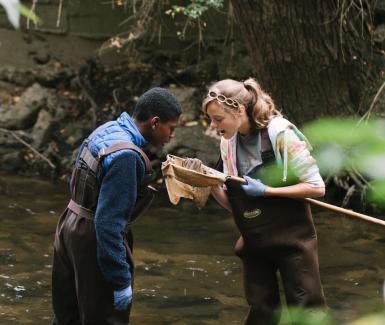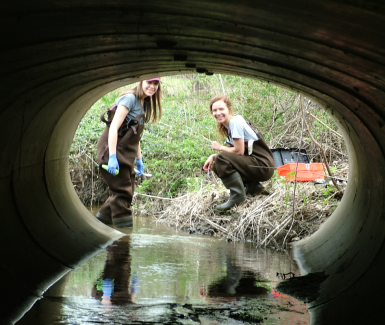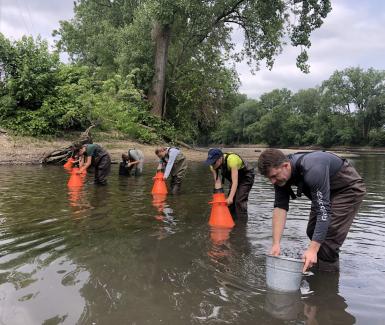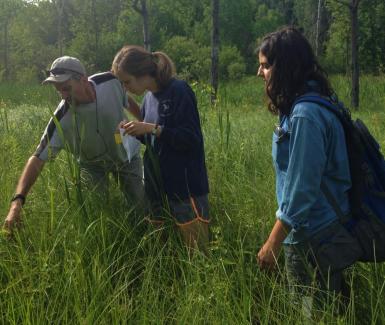Research
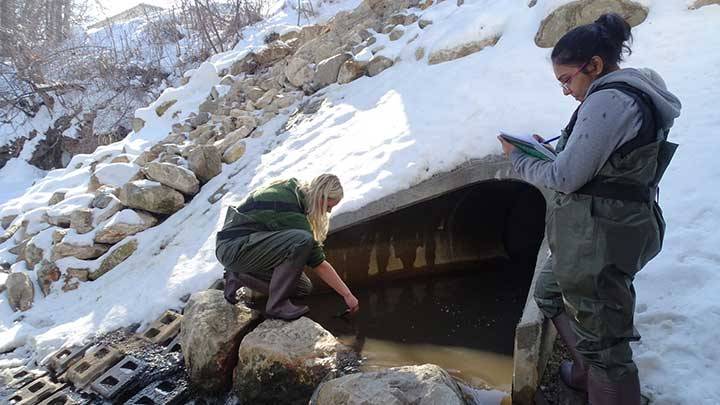
As Plaster Creek Stewards is a part of Calvin University, it is natural to take the plunge into research. We need to ask questions, investigate, listen, and learn more.
With increased emphasis on undergraduate research experience nationally, Calvin redesigned its biology core curriculum in 2011 to include a sophomore level ‘Research Methods’ class, a course that uses the Plaster Creek Watershed as its living laboratory. Students learn how to do research in small groups by designing and carrying out a research project focused on the health of Plaster Creek. The students present the findings of their project at a public forum at the end of each spring semester.
While these student research projects yield helpful information and new findings, we began a summer program where student research assistants would continue to collect data and effectively extended the duration of several key projects. For example, one grant funded 4 additional students during both the school year and summer to identify the main sources of Plaster Creek’s bacterial contamination. In addition to biological research, we continue to work on a social research oral history project, collecting stories and memories from people who have lived, worked, and gone to school or church within the Plaster Creek watershed over the past 80 years. These stories have become a great way to engage the public in caring for the watershed.
We are proud of the variety of research done by students, faculty and professionals.
Each summer Calvin students apply and are hired for specific research positions that advance our research and restoration work. These students have proven to be invaluable to our work as researchers, hard workers, educators, and volunteer site leaders throughout the year.
2022 Summer Projects
Urban Habitat Restoration with Green Team High School Students
Students will mentor, help supervise, and work alongside the Plaster Creek Stewards Summer Green Team, a program that employs high school students to gain experience learning how to implement and maintain green-infrastructure projects. Responsibilities will include greenhouse and nursery management, off campus project installations, seed collecting, and planning and guiding the high school student activities. These positions will afford opportunities for coordinating efforts and promoting mutual understanding between high schoolers from urban Grand Rapids (Plaster Creek Green Team). Besides helping to educate high school students, this work will also provide opportunities for the Calvin mentor to cultivate cross-cultural relationships and practice their Spanish (although being a Spanish speaker is not a requirement).
Ecological Restoration in the Plaster Creek Watershed
Students will work closely with Ms. Deanna Geelhoed and Professor David Warners in the preparation and installation of a variety of restoration projects from small residential curb-cut rain gardens to a large-scale floodplain restoration. Additionally, these students will assist in maintaining areas that were restored in years past, and will become involved in all aspects of plant propagation including seed collection, germination, transplanting, and out-planting. This work will provide students with practical, hands-on opportunities to learn about low-impact development and green infrastructure best management practices.
Monitoring Native Trees to Control Invasive Species and Improve Water Quality
The student filling this position will be focused on monitoring native trees in the Plaster Creek Watershed that have already been planted to improve water quality and discourage the invasive Reed canary grass. This student will be working closely with Dr. David Warners and Ms. Deanna Geelhoed to assess how effective a 2-year-old native tree planting has been. This student will learn about native tree identification and nursery care. An important task of this project will be adding to a baseline dataset that will be used in future years to monitor the success of this project. Part of this dataset will be to quantify the transpiration rates of different trees to determine which trees are best at moving stormwater from the soil into the air. Interested students will need to be willing to work outdoors in all kinds of weather and willing to invest in challenging physical labor.
Plant Responses to Climate Change at Flat Iron Lake Preserve
This project will take place at Calvin's Flat Iron Lake Preserve where 2 students will live and act as summer caretakers. Dr. Warners' project is an ongoing flower phenology study, investigating the timing of flowering periods for a variety of native prairie plants. Through this long-term field study our objective is to document the variety of responses to climate change exhibited by the diverse plants at the Flat Iron Lake Preserve. In addition, this year the student will be collecting data to assess the impact of controlled burning on a restored prairie ecosystem.
Ecological Restoration on Calvin's Campus
The student who fills this position will work in the greenhouse, nursery and at sites on campus to introduce and maintain native plants and native habitats in natural areas. Some of this work will be in coordination with staff from Calvin's Physical Plant Department, with 2022 projects including maintenance of the rain garden east of Spoelhof Cafe and enhancement of the new restored forest area west of Spoelhof Center. Other sites on campus that will be managed include the natural areas adjacent to Van Reken Residence Hall, Dice Museum, DeVries Hall, and Ravenswood Guest House. Students interested in this project will need to be willing to work outdoors in all kinds of weather and willing to invest in challenging physical labor.
Urban Restoration Intern
This position focuses on how to maintain urban green spaces to promote biodiversity and ecosystem services. This student will lead restoration activities that focus on a 5-acre urban wetland (Calvin Avenue Basin), as well as a 5-acre rural floodplain restoration. The main tasks will include invasive species identification and eradication, growing and planting native plants and trees, spraying herbicide when necessary, leading workdays, and working with the Plaster Creek Stewards team to install other green infrastructure projects. Pending funding, it is possible this position could continue part time into the fall term.
Emma Cole Project: Botanical Changes in West Michigan 1901-2021
From 1892 to 1899 Emma J. Cole, a botanist and teacher, traveled around the Grand Rapids area by horse and buggy, collecting and documenting plant diversity of West Michigan. In 1901, she published “Grand Rapids Flora,” a comprehensive record of the plants growing in local areas. Over the past 6 years Calvin's Emma Cole Project has been creating a modern botanical inventory of the Grand Rapids region and comparing it to the flora documented by Emma Cole 120 years ago. 2022 field work will focus on Little Pine Island Lake and Reeds Lake. Botanical inventory lists will be generated and used to calculate Floristic Quality Indices (FQIs) by site. Community similarity measures will be used to compare current day inventories with those gleaned from Cole's work.
Monitoring Floodplains
"This position will implement a variety of strategies for measuring the changes in stream function of two floodplain restoration projects. The student will work in the creek and in the office. Some tasks include measuring floodshelf and bank dimensions in the field, collecting data throughout the watershed, researching similar projects, compiling data with an existing set, and writing a “success story” detailing the two projects in a report. A portion of this work will also be implementing restoration projects in the field with the Plaster Creek Stewards Team. This position is a crossover with the Engineering department.
Green Infrastructure Parking lot Retrofits for Increased Sustainability
This student will assist in expanding water quality improvement efforts in urban areas by working with partners to identify ways to capture stormwater from impervious parking lots in commercial locations and then to develop construction plans and design aids for these efforts. An objective of this position is to develop an educational pamphlet that outlines a range of Green Infrastructure options for parking lots from which businesses and organizations can choose. The student will draw from existing materials and tools and participate in conversations with partners and local engineers to create a user-friendly resource customized to local conditions. The pamphlet will be designed for the public and include cost-benefit analysis, a decision tree, information about maintenance needs for the various options, and stormwater credit estimates. Engineering experience preferred, but not required.
Effectiveness of Plants in Urban Detention Pond
This project seeks to isolate the reduction in stormwater runoff due to native plants through evapotranspiration and increased infiltration. Using a wet-detention pond and a weather station, the project will track stormwater runoff into and out of the pond to determine the changing storage capacity and reductions due to plants. Work will be conducted both in the field and in the office. It will be a mix of research, methods development, data collection, hydraulic calculations, Excel, and writing. This position requires engineering experience, preferably someone who has taken ENGR 320.
Student Research Posters and Papers
2022
Urban Insect Biodiversity - Effects of Native Landscaping
Caedmon Morgret and Dr. David Warners
Stomatal Conductance and Reed Canary Grass Suppression Traits of Native Michigan Trees
David E. Martinez Vasquez and Dr. David Warners
The Emma Cole Project: Reevaluating the Flora of Grand Rapids
William Hofmann, Hayden Janssen, Martin Vanderschoot, Dr. Garrett Crow, Dr. David Warners
Plaster Creek Stewards - Urban Habitat Restoration with Green Team
Jia Luchs, Clare Doss, Rachel Warners, Dr. Dave Warners, Deanna Geelhoed
Green Infrastructure in Parking Lot Retrofits
Delaney Sall and Professor Julie Wildschut
The Influences of Green Infrastructure on Levels of Somatic and Male-Specific Coliphages at Shadyside Park
Oula Salih
2021
Stomatal Conductance and Reed Canary Grass Suppression Traits of Native Michigan Trees
David E. Martinez Vasquez, Martin L. Vanderschoot, and Dr. David Warners
Green Team - Ecological Restoration of Plaster Creek
Jia Luchs, Caleb Mathai, Rachel Warners, Dr. David Warners, Deanna Geelhoed
2020
Plaster Creek Stewards Green Team Initiative
Michael Akpabey, David Martinez Vasquez, Dr. David Warners, Calvin University
Stormwater Capture via Green Infrastructure in the Plaster Creek Watershed
Brett Barents, Kiara Bromley, Haley Weesies, Deanna Geelhoed, Dr. David Warners, Calvin University
Trees vs. Reed Canary Grass
Josian Aardema, Moses Jangala, David E. Martinez Vasquez, Dr. David Warners, Calvin University
Native Plant Transpiration Research in Urban Curb-Cut Rain Gardens with Plaster Creek Stewards and Michigan Sea Grant
Ana Singh, Deanna Geelhoed, Dr. David Warners, Calvin University
Watch presentation (1:38:48 - 1:45:34)
Tree Planting to Inhibit Reed Canary Grass Growth and Watershed Education
David Martinez Vasquez, Deanna Geelhoed, Dr. David Warners, Calvin University
Watch presentation (1:45:34 - 1:53:54)
2019
Green Team: Ecological Restoration of Plaster Creek
Yeri Kim, Benjamin Steenwyk, Rachel Warners, Dr. David Warners, Dr. Gail Heffner, Calvin University
Stormwater Capture via Green Infrastructure in the Plaster Creek Watershed
Kyle Dankert, Ana Singh, Deanna Geelhoed, Dr. David Warners, Calvin University
Podophyllum peltatum: Relationship of Colony Size and Age
Emily Holst, Heidi Keswick, Dr. David Warners, Calvin University
2017
Green Team-Urban Ecological Restoration
Araceli Eikenberry, Stephanie Praamsma, Dr. Gail Heffner, and Dr. David Warners, Calvin College
Stormwater Capture via Green Infrastructure in the Plaster Creek Watershed
Skyler Fish, Ben Johnson, Deanna Geelhoed, Dr. Dave Warners, Calvin College
Plant Performance in Curb Cut Rain Gardens
Max DeYoung, Gregory Manni, Dr. Dave Warners, Calvin College
2016
Curb-Cut Rain Garden Research
Patrick Jonker, and Dr. Dave Warners, Calvin College
The Green Team and the Restoration of Plaster Creek
Leira Lew, Micah Warners, Dr. Gail Heffner, and Dr. David Warners, Calvin College
Runoff Volume Reduction from SubBasins in Plaster Creek Watershed, Kent County, MI
Professor Julie Wildschut, Engineering; Dena De Kryger, Biology
Mapping Mayapple Growth in Restored Forest
Jonathan Walt, Stephanie Praamsma, Tanner Vincent, Dr. Dave Warners, Calvin College
2015
The Green Team and the Restoration of Plaster Creek
Deanna Geelhoed and Micah Warners, Calvin College
Installation of Rain Gardens in the Alger Heights Community
Wesley Dykstra, Dena De Kryger, Mike Ryskamp, and Dr. Dave Warners, Calvin College
Hydrologic Modeling of the Effects of Stormwater Runoff in Plaster Creek Watershed
Ryan DeGroot, Professor Julie Wildschut and Professor Robert Hoeksema, Calvin College
2014
Assessing a Reconciliation Ecology Approach to Suburban Landscaping: Biodiversity on a College Campus
Christopher Bouma, Emily Huizenga, and David Warners, Calvin College
During the first half of each spring semester students in a sophomore-level Biology class (BIO 250) gather water quality data, including flow rates, E. coli concentrations, and more. These data are used to track changes in water quality over time. In the second half of this class students split up into research groups to plan, implement, and analyze data focused on a particular research topic. Past groups have done projects that include antibiotic resistance in stream bacteria, heavy metals in near-stream soils, effect of invasive plants on soil chemistry, influence of a feral cat population on local bird abundance, and nutrient runoff from golf courses. A list of the projects done in 2019 can be found here. Individual research projects for 2020 were disrupted by Covid19 restrictions.
Plant Germination and Performance
Determining the Optimal Light and pH Conditions for Germinating Anthoxanthum ordoatum (Sweet Grass), Aralia racemosa (American Spikenard), and Clintonia borealis (Bluebead Lily)
Michael Akpabey, Ryan German, Nancy Massa, and Bethany Williams
Effects of Biochar on Growth of Native North American Plants
Micah Meindertsma, Sage Riley, and Drew Van Andel
Analyses of Urban Curb-Cut Rain Garden Soils in the Alger Heights Neighborhood of Grand Rapids Using Ion Chromatography and Bioassay
Madi Brink, Patience Buckley, Ethan Houskamp, Ana Singh
Effects of Agricultural Runoff on Radish Growth
Lauren Martin, Lucie Shippert, Anthony Sickman
Land Use and Water Quality
Determining the Effect of Water Quality on Stream Macroinvertebrates Above and Below Stormy Creek Golf Course
Dena Baker, Ricky Ebenezer, Heidi Keswick, and Chris Ralph
Water Chemistry and Potential Effects on the Relative Abundance of Amphibian Egg Masses in the Plaster Creek Watershed
Meghan Economou, Betty Kliewer, and Kelli Laube
Effects of Land use on Fish Populations in Plaster Creek
Lucas DeGroot, Isaac Favila, Liam Ferraby, Daniel Jensen
Effects of Urbanization on Water Quality Parameters at the Calvin College Ecosystem Preserve
Alexander Exler, Kyle Musch, Simon Paul, and Dominic Timmer
Growing out of the benefits and success of using Plaster Creek as a living laboratory for Biology classes, we have expanded that lab to other departments including Chemistry, Engineering, Geology, Geography, and Earth Sciences.
Several groups of freshmen have directed their service project towards Plaster Creek Stewards, designing ways to improve seed processing and stream data collection for Plaster Creek Stewards. Most years, we have a senior design team who spends the entire year working to solve a watershed problem. One team took a detailed look at a nearby church property to see if they could find ways to infiltrate all of the stormwater runoff from the property and thus eliminate the erosion caused by this site downstream. Geography students have learned how to survey and understand soil layers at some of the Plaster Creek project sites, providing useful data for future work or even senior design teams.
Senior design research projects
2021-2022
Creation Connections: Visualizing and Utilizing a Ravine
Bryce Bundens, Alex Newell, Hannah Smith
Creation Connections sought to provide access for students of all mobility levels at Grand Rapids Christian Middle School (GRCMS) to outdoor learning spaces through the design of a 20-year masterplan.
Sedi-Sensor: Pollution Monitoring in Plaster Creek
Joseph Lewis, Kris Miedema, Christian Ro, Isaac Spackman, Moses Yang
Pollution reduction in Plaster Creek is difficult to quantify. This team deployed a turbidity probe capable of retrieving data sufficient to study intermittent flooding.
2018
The Infiltrators—Christ Church property design for storm water neutrality
Megan Daubenmier, Elvin Vindel, Peter Wagenmaker, Steven Johnson
Considering limited access to and scarcity of clean water in the world today, it is no surprise that our team of four Civil/Environmental Engineers chose a project that will help to conserve fresh water by restoring an impaired waterway.
The Par-fect Stream: Indian Creek Restoration at Indian Trails Golf Course
Joe Jackson, Ben Vandyk, Heidi Boeve, Kyle VanDeWeert
Indian Creek, a tributary to Plaster Creek flows through Indian Trails Golf Course. During rainfall events, the 1000 acre watershed, consisting of mostly impervious surfaces collects rainfall and sends it into Indian Creek.
Ongoing student research projects
Evaluating Green Infrastructure Effectiveness
Engineering students spend several summers field-testing the question of how much stormwater runoff is actually entering the curb cut rain gardens in the Plaster Creek watershed? The information gathered during this research led to a better understanding of the performance of these rain gardens which allows for better planning and management within the watershed.
2017
Evaluating the Effectiveness of Curb Cut Rain Gardens in Terms of Storage Volume and Sediment Removal
Lorena De Almeida, Professor Julie Wildschut, Calvin College
2016
Runoff Volume Reduction from SubBasins in Plaster Creek Watershed, Kent County, MI
Professor Julie Wildschut, Engineering
Dena De Kryger, Biology
2015
Hydrologic Modeling of the Effects of Stormwater Runoff in Plaster Creek Watershed
Ryan DeGroot, Professor Julie Wildschut and Professor Robert Hoeksema, Calvin College
Faculty and Professional Research
2022
Botanical Assessments of High-Quality Southern Shrub-Carr and Hardwood Swamp Wetlands in the Undeveloped Lowell Regional Greenspace, Kent County, Michigan
Garrett E. Crow, David P. Warners, Haley R. Weesies, Jonathan D. Walt, Zachary E Hartwig, Carolyn R. Koehn
View presentation PDF
Botanical Inventory Highlights and Management Considerations for Covenant Park
Dr. David Warners, Dr. Garrett Crow, Haley Weesies
FQA metrics PDF
Plaster Creek Floodplain and Adjacent Ravines near Stanaback Park: Botanical Inventory Highlights and Management Considerations
Dr. David Warners, Dr. Garrett Crow, Haley Weesies
Inventory Report
Inventory Results
Botanical Inventory and Management Consideration for Potential Park at 32nd Street Property City of Grand Rapids Parks and Recreation
Dr. David Warners, William Hofmann, Hayden Janssen, Martin Vanderschloot, Dr. Garrett Crow
Indicator species characterization and removal in a detention pond in the Plaster Creek Watershed
Luke Vander Meer, Katherine DeHeer, Joseph Mellinger, Sarah Gibes, Bradley Paasch, Julie Wildschut, William L Miller, Sheng-Yang He, Kelly N DuBois
Relative Success of Native Plants in Curb Cut Rain Gardens
Ana Singh, Jonathan Walt, Patrick Jonker, Rachel Warners, and David P. Warners
Stomatal Conductance and Reed Canary Grass Suppression of Native Michigan Trees
David E. Martinez Vasquez, Martin L. Vanderschoot, and David P. Warners
2020
Rate of Transpiration Across Different Species Over 3 Years
Ana Singh and David P. Warners
2017
Plaster Creek Bacterial Monitoring and Source Tracking Project
Randall DeJong
2015
Plaster Creek Hydrology Study
Julie Wildschut
2014
Biological Surveys of Selected Lower Grand River Streams
Michigan Department of Environmental Quality Water Resources Division
A Summary of Three Antibiotic Resistant Bacteria Studies of Plaster Creek
YeaEun Lee and David P. Warners
2012
BMP Planning to Address Urban Runoff Plaster Creek Watershed SUSTAIN Pilot
Tetra Tech Inc., 2012
1997
Biological Survey of Plaster Creek
State of Michigan Department of Natural Resources Water Quality Division Biology Section







